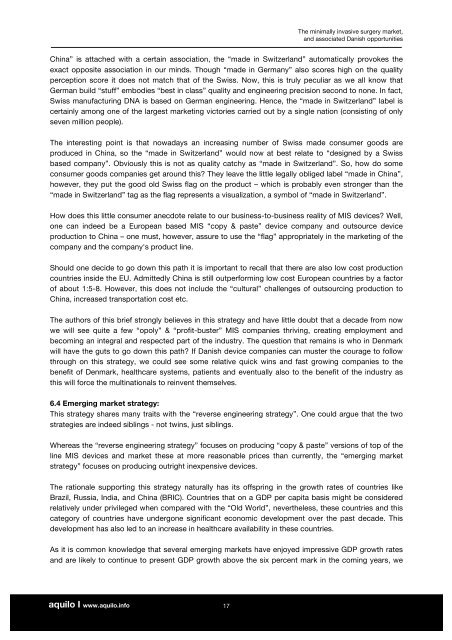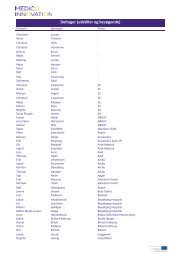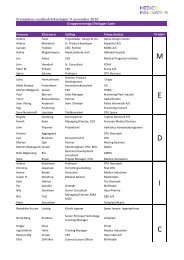The minimally invasive surgery market, and associated Danish ...
The minimally invasive surgery market, and associated Danish ...
The minimally invasive surgery market, and associated Danish ...
You also want an ePaper? Increase the reach of your titles
YUMPU automatically turns print PDFs into web optimized ePapers that Google loves.
aquilo I www.aquilo.info<br />
17<br />
<strong>The</strong> <strong>minimally</strong> <strong>invasive</strong> <strong>surgery</strong> <strong>market</strong>,<br />
<strong>and</strong> <strong>associated</strong> <strong>Danish</strong> opportunities<br />
China” is attached with a certain association, the “made in Switzerl<strong>and</strong>” automatically provokes the<br />
exact opposite association in our minds. Though “made in Germany” also scores high on the quality<br />
perception score it does not match that of the Swiss. Now, this is truly peculiar as we all know that<br />
German build “stuff” embodies “best in class” quality <strong>and</strong> engineering precision second to none. In fact,<br />
Swiss manufacturing DNA is based on German engineering. Hence, the “made in Switzerl<strong>and</strong>” label is<br />
certainly among one of the largest <strong>market</strong>ing victories carried out by a single nation (consisting of only<br />
seven million people).<br />
<strong>The</strong> interesting point is that nowadays an increasing number of Swiss made consumer goods are<br />
produced in China, so the “made in Switzerl<strong>and</strong>” would now at best relate to “designed by a Swiss<br />
based company”. Obviously this is not as quality catchy as “made in Switzerl<strong>and</strong>”. So, how do some<br />
consumer goods companies get around this? <strong>The</strong>y leave the little legally obliged label “made in China”,<br />
however, they put the good old Swiss flag on the product – which is probably even stronger than the<br />
“made in Switzerl<strong>and</strong>” tag as the flag represents a visualization, a symbol of “made in Switzerl<strong>and</strong>”.<br />
How does this little consumer anecdote relate to our business-to-business reality of MIS devices? Well,<br />
one can indeed be a European based MIS “copy & paste” device company <strong>and</strong> outsource device<br />
production to China – one must, however, assure to use the “flag” appropriately in the <strong>market</strong>ing of the<br />
company <strong>and</strong> the company's product line.<br />
Should one decide to go down this path it is important to recall that there are also low cost production<br />
countries inside the EU. Admittedly China is still outperforming low cost European countries by a factor<br />
of about 1:5-8. However, this does not include the “cultural” challenges of outsourcing production to<br />
China, increased transportation cost etc.<br />
<strong>The</strong> authors of this brief strongly believes in this strategy <strong>and</strong> have little doubt that a decade from now<br />
we will see quite a few “opoly” & “profit-buster” MIS companies thriving, creating employment <strong>and</strong><br />
becoming an integral <strong>and</strong> respected part of the industry. <strong>The</strong> question that remains is who in Denmark<br />
will have the guts to go down this path? If <strong>Danish</strong> device companies can muster the courage to follow<br />
through on this strategy, we could see some relative quick wins <strong>and</strong> fast growing companies to the<br />
benefit of Denmark, healthcare systems, patients <strong>and</strong> eventually also to the benefit of the industry as<br />
this will force the multinationals to reinvent themselves.<br />
6.4 Emerging <strong>market</strong> strategy:<br />
This strategy shares many traits with the “reverse engineering strategy”. One could argue that the two<br />
strategies are indeed siblings - not twins, just siblings.<br />
Whereas the “reverse engineering strategy” focuses on producing “copy & paste” versions of top of the<br />
line MIS devices <strong>and</strong> <strong>market</strong> these at more reasonable prices than currently, the “emerging <strong>market</strong><br />
strategy” focuses on producing outright inexpensive devices.<br />
<strong>The</strong> rationale supporting this strategy naturally has its offspring in the growth rates of countries like<br />
Brazil, Russia, India, <strong>and</strong> China (BRIC). Countries that on a GDP per capita basis might be considered<br />
relatively under privileged when compared with the “Old World”, nevertheless, these countries <strong>and</strong> this<br />
category of countries have undergone significant economic development over the past decade. This<br />
development has also led to an increase in healthcare availability in these countries.<br />
As it is common knowledge that several emerging <strong>market</strong>s have enjoyed impressive GDP growth rates<br />
<strong>and</strong> are likely to continue to present GDP growth above the six percent mark in the coming years, we







